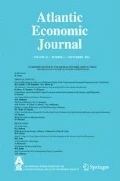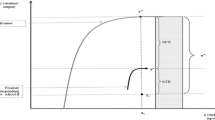Abstract
This paper examines the productive efficiency of government schools in New South Wales (NSW) in Australia. The study uses a technical inefficiency effects model applied to a unique three-year panel dataset containing 1235 primary and 371 secondary schools in NSW. A stochastic frontier production function and an inefficiency effects function that control for school socioeconomic and environmental factors are estimated. The dataset contains information on various school inputs, school expenditures by major functional area, parental socioeconomic characteristics, student characteristics, and standardized test scores. We examine the degree to which school and non-school educational inputs influence student achievement scores and find that, overall, primary schools are 88.6% and secondary schools 96.4% efficient. The index describing community socio-educational advantage has the most significant influence on students’ achievement scores.
Similar content being viewed by others
Notes
The test scores for each subject area are aggregated. For primary schools, the weights assigned for 3rd and 5th grade are 0.4 and 0.6. For secondary schools, the weights for 7th and 9th grades are 0.4 and 0.6, respectively.
The ICSEA index is constructed from socio-educational elements over which the school has very little control, such as average income, level of education, and the type of employment for the household of students enrolled in schools (NSW DET 2010).
References
Abedi, J. (2002). Standardized achievement tests and English language learners: Psychometrics issues. Educational Assessment, 8(3), 231–257.
Australian Curriculum Assessment and Reporting Authority (2010). NAPLAN achievement in reading, writing, language conventions and numeracy: National Report for 2010, ACARA, Sydney, Australia.
Battese, G. E., & Coelli, T. J. (1992). Frontier production functions, technical efficiency, and panel data with application to paddy farmers in India. Journal of Productivity Analysis, 3, 153–169.
Battese, G. E., & Coelli, T. J. (1995). A model for technical inefficiency effects in a stochastic frontier production for panel data. Empirical Economics, 24, 325–332.
Battese, G.E., & Broca, S. S. (1997). Functional forms of stochastic frontier production function and models for technical efficiency effects: A comparative study for wheat farmers in Pakistan. Journal of Productivity Analysis, 8, 395-414.
Blackburn, V., Brennan, S., & Ruggiero, J. (2014). Measuring efficiency in Australian schools: A preliminary analysis. Socio Economic Planning Sciences, 48, 4–9.
Card, D., & Krueger, A. B. (1996). School resources and student outcomes: An overview of the literature and new evidences from north and South Carolina. Journal of Economic Perspective, 10(4), 31–50.
Chakraborty, K. (2009). Efficiency in public education – The role of socio-economic variables. Research in Applied Economics, 1(1), 1–18.
Coleman, J. S. (1988). Social capital in the creation of human capital. American Journal of Sociology, 94, S95–S120.
Coleman, J. S., Cambell, E. Q., Hobson, C. J., McFarland, J., Mood, A. M., Weinfield, F. D., & York, R. L. (1966). Equality of educational opportunity, U.S. government printing office, Washington D.C.
Crespo-Cebada, E., Pedraja-Chaparro, F., & Satin, D. (2014). Does school ownership matter? An unbiased efficiency comparison for regions of Spain. Journal of Productivity Analysis., 41, 153–172.
Currier, S. R. (2007). The choice of estimation method and its effect on efficiency measurement on public education: Stochastic frontier analysis vs. data envelopment analysis. Journal of Economics, 33(1), 53–73.
Edwards, D. (2006). Competition, specialization, and stratification: Academic outcomes of the government school system in Melbourne, Australia. Paper presented at the annual conference of the Comparative Education Society in Europe, Granada, Spain.
Fry, R. (2008). The role of schools in the English language learner achievement gap. Report, pew Hispanic center. June 26. At www.pewhispanic.org.
Gonski, D. (2012). Review of funding for schooling. Final report. Dec. Canberra: Commonwealth Government.
Greene, W. (2001). New developments in the estimation of stochastic frontier models with panel data. Paper presented at the 7th European workshop on efficiency and productivity analysis, University of Oviedo, Spain. Sept 25.
Greene, W. (2002a). Alternative panel data estimators for the stochastic frontier models. Department of Economics, Stern School of Business, New York University. Working Paper.
Greene, W. (2002b). Fixed and random effects in stochastic frontier models, Department of Economics, Stern School of Business, New York University. Working Paper.
Grosskopf, S., Hayes, K. J., Taylor, L. R., & Weber, W. L. (2001). On the determinants of school district efficiency: Competition and monitoring. Journal of Urban Economics, 49, 453–478.
Hanushek, E. A. (1986). The economics of schooling: Production and efficiency in public schools. Journal of Economic Literature, 24, 1141–1177.
Hanushek, E. A. (2003). The failure of input based schooling policies. The Economic Journal, 113, 64–98.
Hanushek, E. A., & Luque, J. A. (2002). Efficiency and equity in schools around the world, NBER. Working Paper.
Jondrow, J., Lovell, C. A. K., Materov, I. S., & Schmidt, P. (1982). On the estimation of technical inefficiency in the stochastic frontier production function model. Journal of Econometrics, 19, 233–238.
Klien, C. C. (2007). Efficiency versus effectiveness: Interpreting education production studies, Department of Economics and Finance, Middle Tennessee State University. Working Paper.
Kumbhakar, S. C. (1997). Modelling allocative inefficiency in a translog cost function and cost share equations: An exact relationship. Journal of Econometrics, 76, 351–356.
Kumbhakar, S. C., & Lovell, C. A. K. (2000). Stochastic frontier analysis. Cambridge University Press.
Kumbhakar, S. C., Sarkar, S. (2005). Deregulation, ownership, efficiency change in Indian banking: An application of stochastic frontier analysis, theory and application of productivity and efficiency–econometric and DEA approach (Ed) R. Ghosh and C. Neogi. McMillan India Ltd.
Ladwig, G. J., & Allen, L. (2013). Does improving school level attendance lead to improve school level achievement? An empirical of Indigenous educational policy in Australia. Australian Educational Researcher, 41(2), 171–194.
Lamb, S., Rumberger, R., Jesson, D., & Teese, R. (2004). School performance in Australia results from analyses of school effectiveness. Melbourne: University of Melbourne.
Leigh, A., & Gong, X. (2009). Estimating cognitive gaps between Indigenous and non-Indigenous Australians. Education Economics, 17(2), 239–261.
Lubienski, S. T., & Lubienski, C. (2005). A new looks at public and private schools: Student background and mathematics achievement. Phi Delta Kappa, 86(9), 696–699.
Marks, G. N., Cresswell, J., & Ainley, J. (2006). Explaining socioeconomic inequalities in student achievement: The role of home and school factors. Education Research and Evaluation, 12(2), 105–128.
Matear, A. (2006). Equity in education in Chile: The tensions between policy and practice. International Journal of Educational Development, 27(1), 101–113.
Mavisakalyan, A. (2011). Immigration, public education spending, and private schooling. Southern Economic Journal, 78(2), 397–423.
Millimet, D. L., & Collier, T. (2008). Efficiency in public schools: Does competition matter? Journal of Econometrics, 145, 134–157.
New South Wales Department of Education (2008, 2009, 2010). Annual reports. http://www.dec.nsw.gov.au/about-us/how-we-operate/annual-reports/.
New South Wales Department of Education and Communities (2015). Resource allocation model. http://www.dec.nsw.gov.au.
New South Wales Public Schools Department of Education and Training. (2010). Explaining ICSEA. http://www.schools.nsw.edu.au/media/downloads/schoolsweb/news/announcements/yr2010/jan/what_is_icsea.pdf. Retrieved 2 Aug 2016.
Perry, L. B., & McConney, J. (2010). Does the SES of the school matter? An examination of socioeconomic status and student achievement using PISA 2003. Teachers College Record, 112(4), 1137–1162.
Pugh, G., Mangan, J., Blackburn, V., & Radicic, D. (2015). School expenditure and school performance from new South Wales schools using a dynamic panel analysis. British Educational Research Journal., 40(2), 244–264.
Redmond, G. (2009). What can data on education outcomes reveal regarding Australian children’s right to develop ‘to their fullest potential’? The Economic and Labour Relations Review, 20(1), 35–58.
Reynolds, A. J., & Walberg, H. J. (1992). A process model of mathematics achievement and attitude. Journal for Research in Mathematics Education, 23(4), 306–328.
Rouse, C. E., & Barrow, L. (2006). U.S. elementary and secondary schools: Equalizing opportunity or replicating status quo? The Future of Children, 16(2), 99–123.
Saito, Y., & McIntosh, C. S. (2003). Monitoring inefficiency in public education. Journal of Agriculture and Applied Economics, 35(3), 611–623.
Sirin, S. R. (2005). Socioeconomic status and academic achievement: A meta-analytic review of research. Review of Educational Research Fall, 75(3), 417–453.
Smith, P. C., & Street, A. (2005). Measuring the efficiency of public services: The limits of analysis. Journal of the Royal Statistical Society, Series A, 168(2), 401–417.
Teese, R. (1989). Australian private schools, specialization, and curriculum conservation. British Journal of Educational Studies, 37, 235–252.
Wanke, P., Blackburn, V., & Barros, P. (2016). Cost and learning efficiency drivers in Australian schools: A two state network DEA approach. Applied Economics, 48(38), 3577–3604.
Watkins, T. J. (1997). Teacher communication, child achievement, and parent traits in parent involvement models. Journal of Educational Research, 91(1), 3–14.
Willms, J. D. (2010). School composition and contextual effects on student outcomes. Teachers College Record, 112(4), 1008–1037.
Acknowledgements
The authors would like to thank Vincent C. Blackburn, Manager, Statistical Performance Reporting, Finance and Investment, Department of Education and Communities, New South Wales for supplying the dataset used for this study. We are also grateful to Vince for providing valuable comments and suggestions on the earlier version of this paper. Special thanks to Prof. Subal Kumbhakar at Binghamton University for his comments and suggestions during the preparation of this manuscript.
Author information
Authors and Affiliations
Corresponding author
Rights and permissions
About this article
Cite this article
Chakraborty, K., Harper, R.K. Measuring the Impact of Socio-Economic Factors on School Efficiency in Australia. Atl Econ J 45, 163–179 (2017). https://doi.org/10.1007/s11293-017-9542-x
Published:
Issue Date:
DOI: https://doi.org/10.1007/s11293-017-9542-x




